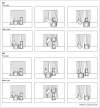Event categorization in infancy
- PMID: 15866192
- PMCID: PMC4215955
- DOI: 10.1016/s1364-6613(00)01836-2
Event categorization in infancy
Abstract
Recent research suggests that one of the mechanisms that contribute to infants' acquisition of their physical knowledge is the formation of event categories, such as occlusion and containment. Some of this research compared infants' identification of similar variables in different event categories. Marked developmental lags were found, suggesting that infants acquire event-specific rather than event-general expectations. Other research - on variable priming, perseveration, and object individuation - presented infants with successive events from the same or from different event categories. To understand the world as it unfolds, infants must not only represent each separate event, but also link successive events; this research begins to explore how infants respond to multiple events over time.
Figures






References
-
- Piaget J. The Origins of Intelligence in Children. International University Press; 1952.
-
- Piaget J. The Construction of Reality in the Child. Basic Books; 1954.
-
- Aguiar A, Baillargeon R. 2.5-month-old infants’ reasoning about when objects should and should not be occluded. Cogn. Psychol. 1999;39:116–157. - PubMed
-
- Baillargeon R, et al. Object permanence in 5-month-old infants. Cognition. 1985;20:191–208. - PubMed
-
- Goubet N, Clifton RK. Object and event representation in 6.5-month-old infants. Dev. Psychol. 1998;34:63–76. - PubMed
Grants and funding
LinkOut - more resources
Full Text Sources

